Airborne Optronics Market Overview, 2032
The global airborne optronics market size was valued at $1.5 billion in 2022, and is projected to reach $4.8 billion by 2032, growing at a CAGR of 12.4% from 2023 to 2032.Airborne optronics refers to a technology that integrates optical and electronic systems to enhance airborne surveillance, navigation, and targeting capabilities. It is a crucial component in military helicopters, aircraft, satellites, and drones, providing advanced functionalities such as surveillance, reconnaissance, target acquisition, aerial imaging, and navigation. It utilizes a combination of electronics and optics to develop systems that use light, imaging sensors, and other electro-optical devices for several applications. It plays a vital role in improving situational awareness, intelligence gathering, and operational effectiveness in both military and commercial applications.
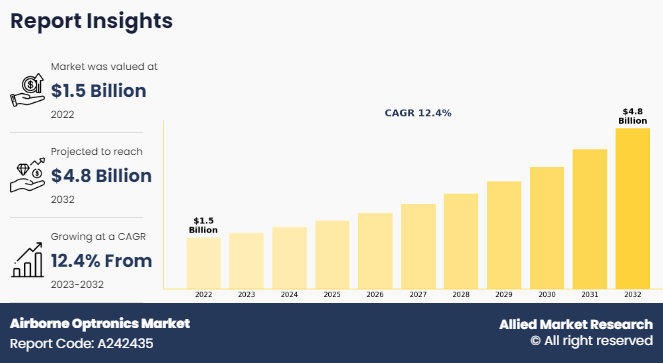
Key Takeaways
• On the basis of the system, the reconnaissance system segment held the largest share in the pitot tubes market in 2022.
• By technology, the multispectral segment held the largest share in the market in 2022.
• On the basis of application, the military segment held the largest market share in 2022.
• By aircraft type, the fixed wing segment held the largest share in the market in 2022.
• On the basis of end use, the OEM segment held the largest market share in 2022.
• On the basis of region, North America held the largest market share in 2022.
Airborne Optronics Market in United States
North America represents the largest share of the airborne optronics market. This is due to steady defense spending and new platform introduction across the U.S. and Canada. The region, led by the U.S., is home to major players in the defense and aerospace industries, such as Lockheed Martin, Northrop Grumman, and Collins Aerospace. These companies encourage innovation and competitiveness by constantly introducing advanced airborne optronics solutions.
Moreover, airborne optronics industry players collaborated with U.S. air force to integrate modern optronics in the UAVs. For instance, in September2021, the United States Air Force (USAF) completed its first operational mission with the RQ-4B Global Hawk Block 30 unmanned aerial system (UAS), equipped with Collins Aerospace’s MS-177 multi-spectral imaging (MSI) sensor. The MS-177 sensor enhances the Global Hawk’s intelligence, surveillance, and reconnaissance (ISR) mission capabilities by providing greater standoff range and actionable intelligence, addressing battlefield challenges, and achieving superiority. The MS-177 family of systems offers long-range ISR capabilities with advanced multispectral imaging, enabling precise target identification and situational awareness day or night, on land or at sea.
The airborne optronics market has witnessed substantial growth in recent years, driven by the surge in demand for advanced situational awareness, intelligence, surveillance, and reconnaissance (ISR) capabilities in both military and commercial applications. This technology involves a wide range of electro-optical and infrared (EO/IR) systems, laser systems, and associated technologies that are integrated into various aerospace platforms, including aircraft, unmanned aerial vehicles (UAVs), and satellites. Moreover, the need for upgrades and maintenance services for current optronics systems is driving a notable increase in demand for aftermarket solutions, according to the airborne optronics market forecast.
To optimize their functionality, several airborne optronics providers receive contracts from aviation companies to install advanced airborne optronics on aircraft. For instance, in April 2021, Safran Electronics & Defense, a Safran SA subsidiary, signed a contract with Dassault Aviation to supply advanced Euroflir 410 optronic systems for two distinct Falcon-based aircraft, a variant of the Falcon 2000LXS, and eight Falcon 50M Triton models undergoing upgrades for the French navy's initiative to modernize its maritime surveillance and intervention aircraft. These new-generation Euroflir 410 optronic systems empower France’s Maritime Surveillance & Intervention Patrol (PATSIMAR) to bolster its covert very-high-altitude observation capabilities and execute maritime search & rescue or zone surveillance missions, even in harsh conditions.
Factors such as surge in adoption of unmanned aerial vehicles (UAVs), increase in focus on intelligence, surveillance, & reconnaissance (ISR), and rise in defense budgets & expenditure drive the growth of the market across the globe. However, high costs associated with the development and complex installation & maintenance of the equipment act as barriers to the growth of the market. Furthermore, development of multispectral & hyperspectral sensors and integration of artificial intelligence (AI) & machine learning are expected to create ample opportunities for the growth of the market during the forecast period.
Segment Review
The airborne optronics market is segmented on the basis of system, technology, application, aircraft type, end use, and region. By system, it is divided into reconnaissance system, targeting system, search & track system, surveillance system, warning/detection system, countermeasure system, navigation and guidance system, and special mission system. By technology, the market is segregated into multispectral and hyperspectral. By application, the market is categorized into commercial, military, and space. By aircraft type, it is classified into fixed wing, rotary wing, urban air mobility, and unmanned aerial vehicles. By end use, it is bifurcated into OEM and aftermarket. By region, the market is analyzed across North America, Europe, Asia-Pacific, Latin America, and Middle East & Africa.
By System
On the basis of system, the reconnaissance system segment generated maximum revenue in 2022, owing to the surge in demand for enhanced intelligence, surveillance, and reconnaissance (ISR) capabilities is driving the growth of airborne reconnaissance systems. The integration of multi-sensor systems, miniaturization, and the need for real-time data processing are further fueling this segment's expansion.
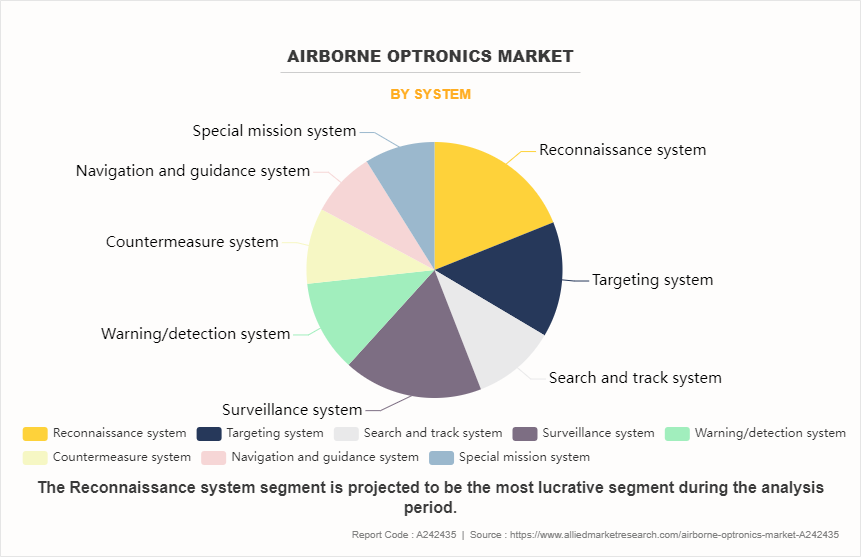
By Technology
On the basis of technology, the multispectral segment generated maximum revenue in 2022, as Multispectral technology is a well-established and cost-effective solution, offering versatile applications across various domains, including defense, commercial, and scientific sectors. Its ability to provide broad spectral coverage and data fusion capabilities is driving its adoption in airborne optronics systems.
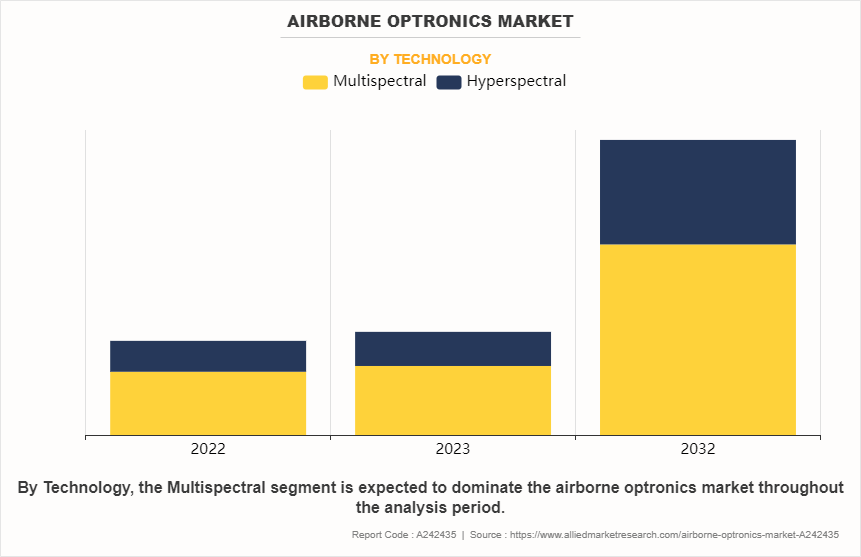
By Application
On the basis of application, the military segment was the highest revenue contributor to the market in 2022, owing to ongoing modernization programs for military aircraft, the need for network-centric warfare capabilities, and the evolving threat scenarios that necessitate advanced optronics systems. The demand for enhanced situational awareness, precision targeting, and electronic warfare capabilities is driving the growth of military airborne optronics.
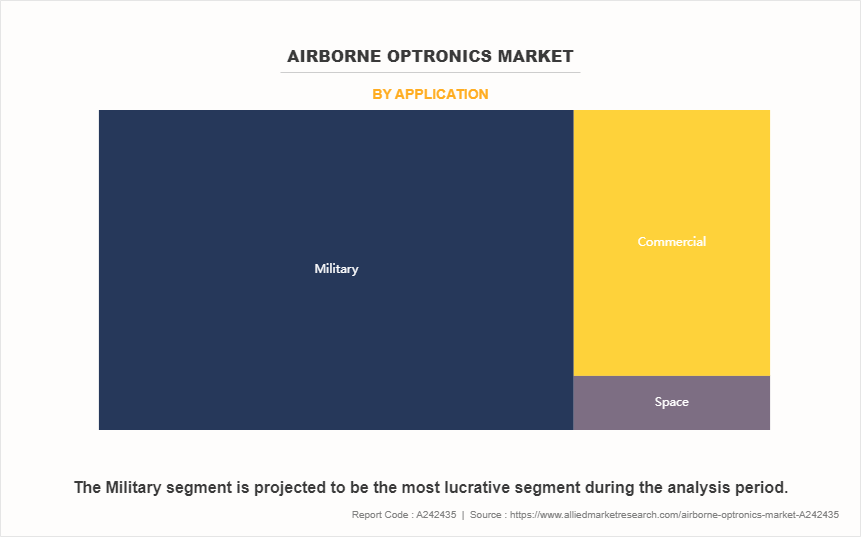
By Aircraft Type
On the basis of aircraft type, the fixed wing segment generated maximum revenue in 2022. The growth of the fixed-wing aircraft segment is driven by new fighter and transport aircraft programs, as well as the need for capability upgrades and multi-spectral sensor integration on existing platforms. The demand for advanced airborne optronics systems, such as targeting pods, reconnaissance systems, and electronic warfare suites, is fueling the growth of this segment.
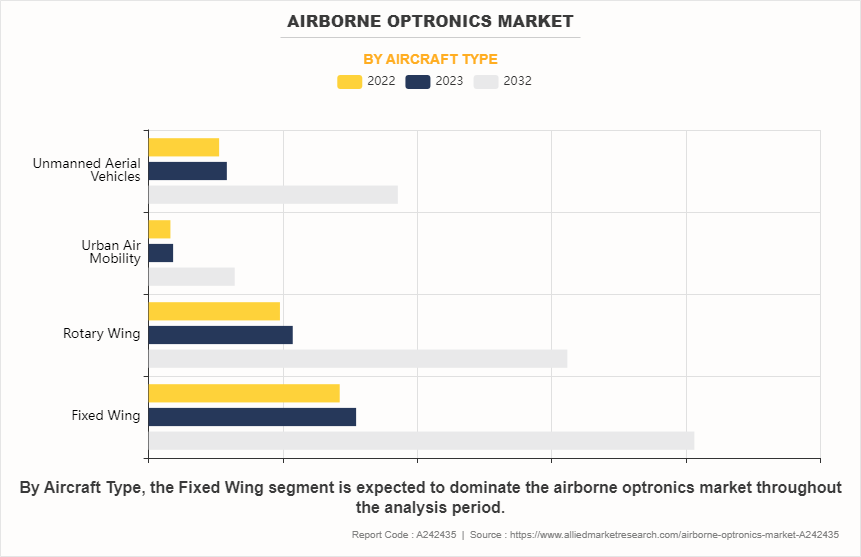
By End Use
On the basis of end use, the OEM segment was the highest revenue contributor to the market in 2022, owing to increase in aircraft production and the incorporation of advanced optronics systems into new platforms by original equipment manufacturers to meet evolving customer requirements.
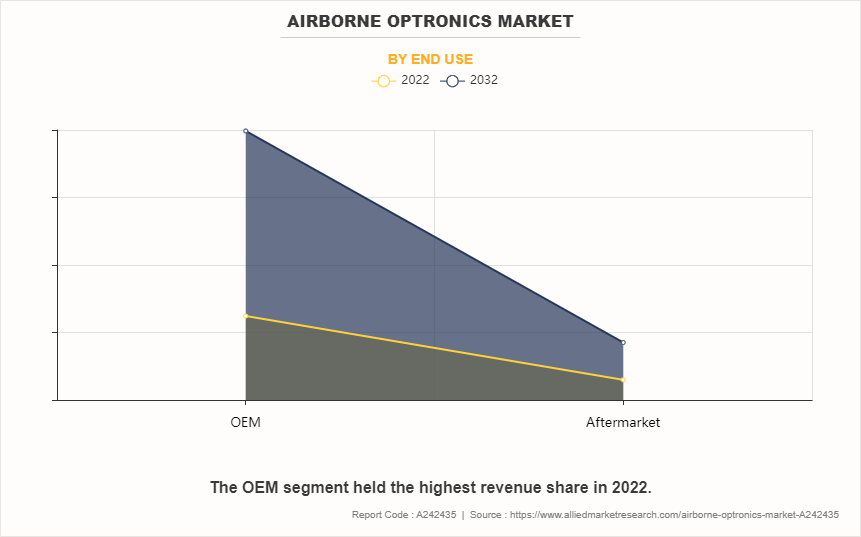
By Region
Based on region, North America dominated the pitot tubes market in 2022. Technological advancements, defense modernization programs, and investments in commercial aerospace driving the growth of the market in countries such as the U.S. and Canada.
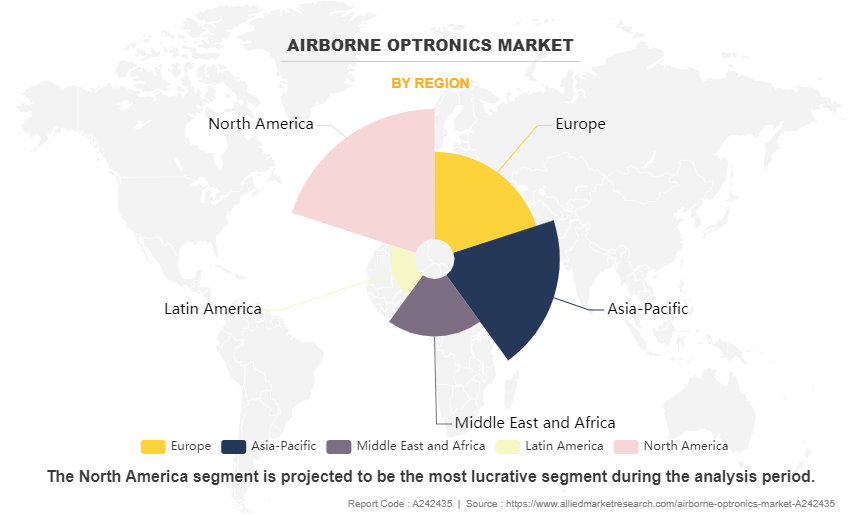
Competitive Analysis
Some of the major companies that operate in the global airborne optronics market include Northrop Grumman Corporation, Thales SA, Safran SA¸ Teledyne FLIR LLC, Elbit Systems Ltd., Leonardo S.p.A., Lockheed Martin Corporation., Hensoldt AG, Collins Aerospace, and L3Harris Technologies, Inc.
Surge in Adoption of Unmanned Aerial Vehicles (UAVs)
The airborne optronics market growth is driven by an increase in the number of unmanned aerial vehicles (UAVs), also referred to as drones. These versatile unmanned systems are increasingly utilized for a wide range of applications, both in the military and commercial sectors. UAVs require advanced optronics systems, such as electro-optical (EO) and infrared (IR) cameras, laser rangefinders, and targeting systems, to effectively carry out their missions. These optronics technologies enable UAVs to perform critical tasks, including surveillance, reconnaissance, target acquisition, and situational awareness, across diverse operational environments.
Moreover, major companies working in the airborne optronics industry are working together to develop advanced airborne optronics for UAVs. For instance, in November 2022, Safran Electronics & Defense, a Safran SA company, signed a contract with Leonardo S.p.A. to develop and deliver the Euroflir 610 airborne electro-optical system for the Eurodrone program. On the basis of the Euroflir 410 design, the Euroflir 610 plays a critical role in European MALE UAV's ISTAR missions (intelligence, surveillance, target acquisition and reconnaissance), offering exceptional observation and target designation capabilities in various environmental conditions, supported by advanced features like multispectral telescope and precise target geolocation. Such developments further increase the airborne optronics market size in forcast period.
In addition, airborne optronics manufactures have introduced UAVs with advanced airborne optronics capabilities ISR missions. For instance, in February 2023, Hensoldt South Africa, a Hensoldt AG comapny launched ARGOS-8 airborne electro-optical system (EOS) at the International Defense Exhibition and Conference (IDEX) in Abu Dhabi, UAE. Weighing less than 6 kg, the ARGOS-8 is a lightweight 8-inch-class EOS equipped with specialized laser products, offering day and night operation for intelligence, surveillance, and reconnaissance (ISR) missions, including intelligence, surveillance, target acquisition, and reconnaissance (ISTAR). Hensoldt South Africa developed and co-produced the ARGOS-8 in partnership with Threod Systems to enhance the capabilities of smaller tactical unmanned aerial vehicle (UAV) systems. Leveraging complementary technologies, the partnership enabled the rapid and efficient introduction of ARGOS-8 to the market. Therefore, with rise in adoption of UAV, the need for advanced yet small optronics solutions is anticipated to increase, which in turn increases the airborne optronics market share of manufactures.
Increased Focus on Intelligence, Surveillance, and Reconnaissance (ISR)
In the modern security landscape, the importance of effective intelligence, surveillance, and reconnaissance (ISR) operations has become increasingly paramount. Both military and law enforcement agencies rely heavily on ISR capabilities to gather critical information, monitor potential threats, and enhance situational awareness. Airborne optronics systems play a vital role in enabling these ISR operations. Advanced electro-optical and infrared sensors, coupled with high-resolution imaging and data processing capabilities, allow real-time monitoring, target tracking, and data collection across diverse environments. The rise in emphasis on ISR operations, driven by factors such as homeland security concerns, border surveillance, and counterterrorism efforts, has directly contributed to the increased demand for sophisticated airborne optronics solutions.
In addition, the optronics sensors provider has equipped various sensors on aircraft for ISR missions. For instance, in May 2023, Sensor solutions provider Hensoldt AG and Brazilian company AEROMOT signed an agreement to install aircraft with advanced sensor technology. The agreement focuses on delivering and integrating the "MissionGrid" mission system, which includes the "PrecISR-1000" radar, the "ARGOS II" optronic observation system, and the necessary data links for operation. Integrated into a Diamond Aircraft DA62 MPP, MissionGrid empowers the aircraft to conduct sophisticated ISR (Intelligence, Surveillance, and Reconnaissance) missions. Starting in 2025, AEROMOT in Porto Alegre is expected to hold exclusive rights to manufacture the DA62. This arrangement enables Hensoldt AG to provide the "MissionGrid Airborne Mission System" for ISR missions on the highly sought-after platform. Such developments further boost the airborne optronics market growth.
Surge in Defense Budgets and Spending Globally
In recent years, many nations across the globe have witnessed a substantial increase in their defense budgets and spending. Several countries, including the U.S., France, Germany, and Spain, have increased military spending in response to geopolitical tensions, security priorities, and the need to retire Soviet-era equipment. Furthermore, U.S. President Joe Biden signed the National Defense Authorization Act for the fiscal year 2023, which allocates $816.7 billion to the Department of Defense. In addition, European Union member states significantly increased their military budgets, with spending expected to reach $295 billion by 2023 as the alliance mobilizes support for Ukraine against Russia's invasion. In addition, the Russian government announced plans to increase defense spending by 68% in 2024.
A significant portion of these defense budgets is allocated toward the acquisition and development of advanced aerospace and defense technologies, including airborne optronics systems. These systems play a crucial role in enhancing the operational effectiveness of military aircraft, UAVs, and other aerospace platforms. The substantial funding allocated to defense programs creates lucrative opportunities for optronics manufacturers to supply innovative solutions and secure contracts in the competitive defense market.
Complex Installation and Maintenance of The Equipment
The complex installation and maintenance of airborne optronics equipment poses significant challenges and costs, acting as a restraint for market growth. These systems are typically integrated into various aerospace platforms, such as aircraft, unmanned aerial vehicles (UAVs), and satellites, which have unique installation requirements and complexities. One of the primary challenges lies in the physical integration of optronics systems into existing or new aerospace platforms. These installations often require specialized expertise, tailored engineering solutions, and extensive testing to ensure proper functionality and seamless integration with other onboard systems. The process is time-consuming and labor-intensive, adding to the overall costs.
In addition, the harsh operating environments encountered by airborne platforms, such as extreme temperatures, vibrations, and electromagnetic interference, place significant demand for optronics equipment. These systems must be designed to withstand such conditions, which increase the complexity and cost of installation and maintenance procedures. Maintenance and repair operations for airborne optronics are costly. These systems require periodic calibration, software updates, and replacement of components due to wear and tear or damage sustained during operations. To mitigate these challenges, optronics manufacturers and end-users need to invest in specialized training programs, advanced maintenance facilities, and robust supply chain management systems, all of which increase the overall costs associated with these systems.
Integration of Artificial Intelligence (AI) and Machine Learning
Advanced computational techniques such as artificial intelligence (AI) and machine learning have the potential to revolutionize the way data is processed and analyzed within optronics systems. By leveraging AI and machine learning algorithms, airborne optronics achieve enhanced capabilities in areas such as object recognition, target tracking, and decision-making.
For instance, AI-powered image analysis enables optronics systems to automatically identify and classify objects of interest with a high degree of accuracy, reducing the workload on human operators. For instance, in June 2022, HGH, a global provider of electro-optical devices, introduced GAIA Artificial Intelligence technology. This innovative AI processing brings unique capabilities to the market, enabling automatic classification of objects within panoramic thermal images. The AI module utilizes three patent-pending neural networks tailored for maritime, land, and air surveillance applications. It classifies targets over long distances and a wide range of sizes, significantly reducing false alarm rates for wide area surveillance while simplifying daily operations for users. In addition, GAIA Artificial Intelligence benefits from the I2QTM image processing library, ensuring superior image quality day or night, regardless of environmental conditions.
Furthermore, AI and machine learning are integrated into targeting and guidance systems, allowing more precise and dynamic target acquisition and engagement. This is particularly valuable in fast-paced combat scenarios where rapid decision-making is crucial. Thus, the rise in adoption of AI and machine learning technologies in various industries presents an opportunity for airborne optronics manufacturers to develop intelligent and autonomous systems.
Recent Developments in the Airborne optronics Industry
• In December 2022, Rafael Advanced Defense Systems Ltd. and Hensoldt AG, sensor solutions provider, announced a collaborative effort to fulfill the Luftwaffe's need for airborne electronic warfare capabilities with Initial Operating Capability (IOC) set for 2028. This joint endeavor aims to integrate and enhance Rafael's Sky Shield airborne electronic warfare pod into a mature off-the-shelf Escort Jammer (ESJ), incorporating Hensoldt AG’s latest airborne electronic attack technology known as KALÆTRON Attack.
• In September 2023, EDGE, a prominent technology company in defense and beyond, signed an agreement with Israel Aerospace Industries (IAI), the primary developer and manufacturer of defense and aerospace systems in Israel. This agreement aims to establish a maintenance center in the UAE for certain systems developed by IAI. The agreement focuses on electro-optics advanced systems, including IAI's POP family (Plug-in Optronic Payload) systems, Mini-POP, and MOSP (Multi-Sensors Optronic Stabilized Payload) surveillance payloads, catering to land, naval, and air applications.
Key Benefits For Stakeholders
- This report provides a quantitative analysis of the market segments, current trends, estimations, and dynamics of the airborne optronics market analysis from 2022 to 2032 to identify the prevailing airborne optronics market opportunities.
- The market research is offered along with information related to key drivers, restraints, and opportunities.
- Porter's five forces analysis highlights the potency of buyers and suppliers to enable stakeholders make profit-oriented business decisions and strengthen their supplier-buyer network.
- In-depth analysis of the airborne optronics market segmentation assists to determine the prevailing market opportunities.
- Major countries in each region are mapped according to their revenue contribution to the global market.
- Market player positioning facilitates benchmarking and provides a clear understanding of the present position of the market players.
- The report includes the analysis of the regional as well as global airborne optronics market trends, key players, market segments, application areas, and market growth strategies.
Airborne Optronics Market Report Highlights
| Aspects | Details |
| Market Size By 2032 | USD 4.8 billion |
| Growth Rate | CAGR of 12.4% |
| Forecast period | 2022 - 2032 |
| Report Pages | 250 |
| By System |
|
| By Technology |
|
| By Application |
|
| By Aircraft Type |
|
| By End Use |
|
| By Region |
|
| Key Market Players | FLIR Systems, Inc., Safran, Thales, Lockheed Martin Corporation., Northrop Grumman Corporation., L3Harris Technologies, Inc., Hensoldt AG, Leonardo S.P.A., Collins Aerospace, ELBIT SYSTEMS LTD. |
Northrop Grumman Corporation, Thales SA, Safran SA¸ Teledyne FLIR LLC, Elbit Systems Ltd., Leonardo S.p.A., Lockheed Martin Corporation., Hensoldt AG, Collins Aerospace, and L3Harris Technologies, Inc.
Largest regional market for Airborne Optronics is North America
Leading application of Airborne Optronics Market is military.
Upcoming trends of Airborne Optronics Market are development of multispectral and hyperspectral sensors and integration of artificial intelligence (AI) and machine learning.
The global airborne optronics market was valued at $1,543.3 million in 2022, and is projected to reach $4,837.3 million by 2032, registering a CAGR of 12.4% from 2023 to 2032.
Loading Table Of Content...
Loading Research Methodology...



